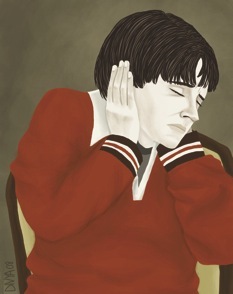 Am I the only one who really likes the UK cover?
Am I the only one who really likes the UK cover?
I don’t read a lot fantasy, mainly because I am too impatient for world building, I find that characters are classified by their surface qualities instead of being organic beings, and villains that are just too one-sided. Enter A Darker Shade of Magic, or ADSOM, a fantasy novel that not only challenges the notion that world building should ever be made tedious, but flaunts the exellent execution of a juicy final act. But did it really succeed in convincing me to love reading fantasy once again?
To Those Who Dream of Stranger Worlds…
Meet Kell, one of the last Anteri, or travelers – essentially magicians that can traverse between dimensions. Completing the obligatory duo, (or trio) Delilah Bard, or Lila, an aspiring pirate, adventurer, and has a general interest in anything potentially fatal because isn’t life just more interesting that way? Toss in some more out of this world magic, political intrigue, a mix of different dimensions and a dice of romance/friendship served on some chilled Scandinavian-esque prose, and you have ADSOM. Ultimately, this is a novel that has all of the pieces to make a fantastic read, but some parts were not used to their fullest potential, albeit the final taste was still pleasant. Lets run it down…
My biggest problem lies within the lengthy exposition to the world(s), in which Schwab does introduce relevant characters, but plot points are sometimes dangled in front of the audience’s noses and never addressed again. A specific case is with King George III and the issues of Grey London – it felt like he was just brought up to give context to the story, but his life, and ultimately the role of a whole world was largely ignored. As interesting and riveting Red and White London is, there has to be joy in life without magic, some sense of adventure, and thrill. When Kell and Lila leave on their adventure, its as if Lila is rejecting her past life, a life filled with ups and downs that seem interesting in its own right. One of her earliest scenes is a scuffle with 3 street ruffians, which showcased both her weakness, and the immense promise that Grey London held in entertainment. While I acknowledge ADSOM is meant to be a fantasy novel, if it intends to bring in our reality, then I do not feel that it is right to simply shrug it off as a naive child who has forgotten the taste of magic. Where is its technology, its culture, its vibrancy? Missing. Schwab starts with the promise of several Londons, but in the end, she only really focuses on two of them.
Also missing is the presence of a complex and well-developed, refreshing villain. A genre as vast as fantasy already possesses blood thirsty rulers, tyrants, dark shadows, mysterious artifacts, and misunderstood heroes as villains in abundance. At the same time, there really is no such thing as a truly evil person, or at least there is nothing believable in a villain who has lost all of their humanity. Whether or the not the villains possess a shred of their morales any longer, Schwab never really gave them a chance to show it, and that is my second big issue with ADSOM – hackneyed and underdeveloped villains. (I feel no struggle, nothing as I am forced to root for Kell, whereas the presence of a strong, multifaceted villain would leave the reader torn, a feeling which shows that the book is truly getting to me.)
Along the same lines, the main characters of ADSOM remind me of … the flat cardboard cut outs that populate much of modern fiction. When I hear the name Kell, I think more of his powers, and his physical traits (especially with the eyes), rather than his “unique” personality. When I hear Lila, I think of thief, pirate, and also her eyes. I never envision this rich blend of emotional rawness from either of them, and even when Lila sheds her tough girl persona, it feels almost false, and a betrayal of what she had previously stood for. As for the rest of the cast, I can hardly remember their names.
My final main issue with ADSOM is with the writing. For the most part, Schwab is very fluid, but in some action scenes, or descriptions of what is generally going on, I had to read some lines twice. Now this might just because the font in my edition was spaced pretty tightly, but I found that this generally interrupted the flow, especially if it was in the middle of an action sequence. Also, I felt for some reason that she had lost her stylistic flair that was present in Vicious, which I would dare say is miles better than ADSOM.
As for the story, the payoff at the end was intense, satisfying, and full of the bells and whistles that characterizes a fantasy climax. But the very end (which I will not spoil) felt almost cheap, too easy, and it seemed like Schwab threw out one of the main driving forces of the book – the tragedy – in place of a more convenient ending. Much simpler, less cathartic, and ultimately made the end not quite worth the 300 page buildup (or maybe that says more about my sadism).
All in all, ADSOM did not quite deliver what it had led me to expect in its exposition, but the promise of future books with the initial groundwork worldbuilding complete is quite delicious. I am expecting a lot from Books 2 and onward (so I guess the answer is yes?)!

Who else is pumped? You don’t have to raise your hands…
3 Stars
















